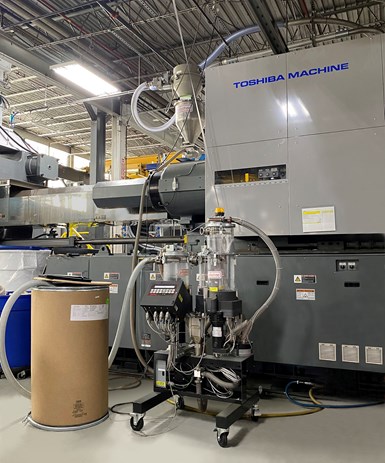System Moves Blending Right to Plant Floor
ColorStream from Plastrac streams colors and other additives to the feed throat of injection molding machines and extruders to mix synchronously with virgin resin in real time.
Plastrac’s patented ColorStream blending system began as a request by a major cable and wire manufacturer that wanted to eliminate the need for employees to climb ladders or stairs to clean and change out additive hoppers that are mounted high above the floor. Plastrac’s response amounts to an entirely new approach to traditional blending methods that it explains decoupled dosing and feed from the main resin, moving blending to the plant floor and streaming colors and other additives to the feed throat of injection molding machines and extruders to mix synchronously with virgin resin in real time.
Color changes and minimal maintenance occur on the plant floor. The cart can also be moved easily to ensure unhindered access to injection molding machines and extruders when maintenance is due. As for ColorStream’s own maintenance, the system’s clean low-pressure transport air ensures there is nothing to clog and very little to clean. ColorStream also dramatically lowers power costs and the need for extra equipment.

Photo: Plastrac
ColorStream’s cart can support one or more additive feeders (importantly, up to four, with precisely the same small footprint as a cart with one feeder) arranged radially around a collecting funnel for discharge of the additives into a vertically mounted, custom-made venturi that discharges downward into a transport hose. Unlike conventional venturi, which require use of high-pressure compressed air from the factory central system, ColorStream uses low-pressure air supplied by an electrically powered regenerative blower located on the cart. These blowers operate continuously for years and deliver clean air because there are no contacting parts requiring lubrication. The venturi and transport hose are small enough to deliver sufficient air velocity to keep transported granules entrained in the air stream.
At the upper end of the system, a compact but sturdy baffle box mounts to the feed throat of the plastics processing machine. The top flange of this box typically supports the customer’s central loader receiver and buffer hopper, which supply virgin material to the process. A cyclone type receiver inside the baffle box separates the additives from the transport air, which is routed out of the baffle box laterally. A metal screen between the cyclone and the exhaust duct guarantees that stray additive granules cannot escape with exhaust air. Additive granules do not clog the screen, because its much larger open area reduces air velocity below that required to lift the granules.
All surfaces are scrubbed by the transport air or by impingement of additive granules, so that color changes do not require cleaning of the hose or baffle box components. ColorStream works with all injection molding, extrusion, and blow molding machines and with all virgin resins, including PET.
The new ColorStream will be on exhibit at October’s K 2022 in Dusseldorf, Germany.
Related Content
-
Software Helps Processors Make Better Business Decisions
NPE2024: Tracker Monitoring and Reporting Software supports ISO reporting and material validation, including PCR usage and equipment status monitoring.
-
Orbetron, Technovel Form Strategic Partnership
Feeding specialist and extrusion builder align to market and sell each other’s offerings.
-
Cut Loading Time Through Direct Charge Blending
Direct charge blender loading, a vacuum-powered automation process, can dramatically improve loading time and reduce material costs. In this article, we address ten common questions to help you determine if the systems are right for your facility.







